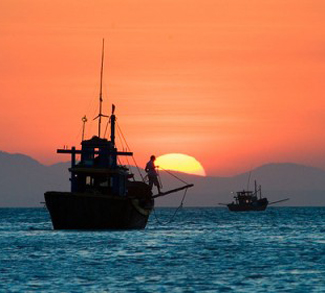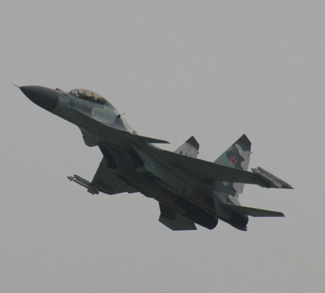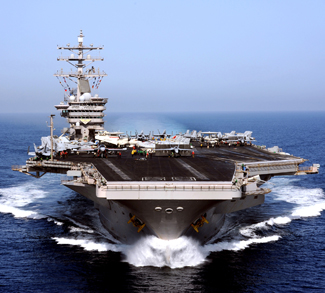Ominous clouds blew in from the Pacific at the conclusion of the historic US-ASEAN Summit in Rancho Mirage, California just as President Obama and the Association of Southeast Asian Nations (ASEAN) senior ministers were pledging to reduce tensions in the South China Sea and seek ways to prevent future conflict.
A joint statement from the U.S. and the 10-member regional grouping – dubbed the “Sunnylands Declaration” because it was authored at the sprawling 200-acre estate of the late billionaire and publishing tycoon, Walter H. Annenberg – calls for respect of each nation’s sovereignty and international law.
However, the summit also dramatically marks the end of the administration’s seven-year resolve to engage, or “rebalance,” towards the Asia–Pacific and to promote the ‘rule of law’ on land and sea. For now, ASEAN’s cohesion is being dramatically challenged by China’s continuing regional ambitions and assertiveness in the contested South China Sea. Notably absent at the summit was China.
“We discussed the need for tangible steps in the South China Sea to lower tensions, including a halt to further reclamation, new construction, and militarization of disputed areas,” Obama said in his concluding statement. “I reiterated that the United States will continue to fly, sail, and operate wherever international law allows, and we will support the right of all countries to do the same.”
Aside from maritime security in the South China Sea, trade and innovation were the summit’s lead discussion topics, and Obama announced several new initiatives. Among them is a program Obama called “US-ASEAN Connect” in which the U.S. will set up “hubs” across the region to connect entrepreneurs and business people.
What is clear is that the trajectory of U.S. engagement towards Asia cannot veer off course before or even after November’s general election. There’s too much at stake. China has emerged as the single largest market for ASEAN exports. To the dismay of Wall Street and ASEAN’s largest economies, China’s financial turbulence has shaken the foundation of emerging regional economies and broadly undermined confidence in overall economic and security issues.
With Beijing exercising claims to more than 80 percent of the South China Sea, it is directly at odds with fellow claimants, especially Vietnam and the Philippines, in a body of water that annually hosts $5 trillion in shipping. Over the past two years, China has reclaimed more than 3,000 acres in the sea and has constructed military facilities there.
While the U.S. has made it perfectly clear to ASEAN leaders that it opposes China’s “militarization” of the disputed territories, Daniel R. Russel, Assistant Secretary of State for East Asian and Pacific Affairs, summed it up that “the ASEAN summit is not about China,” but about creating an ASEAN community committed to rules and fairness.
Despite this American optimism largely from the US multinationals, more issues involving the specific terms of TTP must be resolved.
In an effort to underscore the important role that the U.S. has in the region, Vietnam’s Prime Minister Nguyen Tan Dung, urged Washington to use a stronger voice and “more practical and more efficient actions” towards China’s maritime expansion. Last year marked 20 years since diplomatic relations between Vietnam and the U.S. were restored.
While the premier’s statement did not specifically identify China, all present knew that Dung was indeed referring to “large-scale construction of artificial islands” and to “militarization.”
Just last month, Dung was passed over by the politburo in Hanoi in its nomination of a party chief. This translates as a possible setback for US-Vietnam relations, since both leaders are in a lame duck status. However, it’s an affirmation about how much Washington views Vietnam as a strategic partner, since President Obama has accepted the invitation extended from Dung to visit Vietnam in May.
Many of Washington’s national security exports in the State and Defense departments reinforce that fundamental US interests in the region like stability, freedom of navigation, the free flow of commerce, the promotion of democracy and human rights remain unchanged. Vietnam, Brunei, the Philippines, and non-member Taiwan all have claims – this is a prime example of the forces that threaten to disrupt ASEAN’s cohesion. As China presses its expansive claims to everything within its so-called nine-dash line, Vietnam and the Philippines look to the United States to support their harder line against Beijing. Myanmar, Laos, and Cambodia want nothing to do with the issue. And the rest of ASEAN remain relatively on the sidelines.
Nevertheless, ASEAN’s pragmatism prevails and with it there’s a consensus among leaders that engagement, rather than confrontation, is the optimum policy response. The U.S. and ASEAN strategic policy compass aims at integrating China deliberately into a regional web of economic interdependence and political and security dialogue. The economic picture is not lost on anyone since ASEAN has the world’s 3rd largest population, with over 630 million people. By 2020 around half of the region’s population will be under 30. In addition to these potential consumer dividends, both the U.S. and the regional economies recognize increasing urbanization and rapid technology adoption in the region, making it an attractive market and partner.
It’s no wonder that many business associations were also present to weigh in on the benefits and rules for global trade in the Trans-Pacific Partnership—rules that will argue to increase Made- in-America exports and grow the American economy. For example, The US-ASEAN Business Council (US-ABC) believes that the TPP will benefit Americans and advance US national interests:
“The TPP agreement marks an extraordinary opportunity to open markets and level the playing field for American exporters and investors competing in some of Asia’s fastest-growing markets, including four ASEAN markets. Building on the success of the US-Singapore Free Trade Agreement of 2004, American exports to Singapore have grown by nearly 90 percent. We believe that TPP can offer similar export opportunities in Brunei, Malaysia, and Vietnam in ASEAN,” claims Alexander C. Feldman, president & CEO.
Although the terms of the TPP are finalized, there’s still more heavy lifting to be done. Of course, part of the summit’s mission was to lure ASEAN majors such as Indonesia into the Trans-Pacific Partnership family once it is implemented. The successful conclusion of the TPP negotiations does give the United States an opportunity to strengthen its economic linkages with Asia, before 16 Asia-Pacific nations (10 countries in ASEAN, plus Australia, China, India, Japan, New Zealand, and Australia) conclude the Regional Comprehensive Economic Partnership (RCEP) free trade agreement, a deal which excludes the U.S. Once completed, the combined RCEP nations will represent a $10 trillion dollar trade zone accounting for nearly 30% of world trade and home to 50% of the world’s population.
Despite this American optimism largely from the US multinationals, more issues involving the specific terms of TTP must be resolved. Some Washington policy trade experts seriously doubt if Congress will even address the trade bill until after the November election.
Behind the pink brick wall of the estate, referred to generally as the “Camp David of the West,” many leaders and their coteries did speak about the elephant not in the room but nearby in the South China Sea. The issue was clear: how to deal with China’s rise and its growing sphere of influence. China’s own ASEAN regional game plan, led by its ‘charm offensive seems to be losing appeal and SCS claimants and others are making their opposition known.
“In recent years, Chinese assertiveness in the South China Sea has steadily eroded regional goodwill and led its Southeast Asian neighbors to explore closer relations with each other and outside powers, most of all the United States. Those trends have only strengthened in the wake of China’s ongoing island-building. Beijing’s diplomatic charms and economic carrots are no longer enough to overcome the damage being done by its actions” states Greg Poling, director of the Asia Maritime Transparency Initiative and a fellow at the Center for Strategic and International Studies in Washington.
According to Beijing’s own state-operated media, China has offered more than $3 billion in loans and aid to neighbors Cambodia, Vietnam, Myanmar, Thailand and Laos to improve infrastructure and production, and to fight poverty.
To quell China’s aggressive actions in the South China Sea, the Middle Kingdom dangles mega-infrastructure projects for the region, attempting to present a softer, more cooperative side to its neighbors following months of tension over territorial issues and other problems.
Nevertheless, the charm offensive will face limitations in at least two areas. First, there’s a growing list of countries in Southeast Asia becoming more suspicious of China’s intentions, a trend that is only reinforced by growing economic asymmetry. Secondly, the charm offensive itself does not appear to apply in practice to all of China’s neighbors.
Over the past year, the rhetoric from the U.S., Japan, the Philippines, and Vietnam escalates for almost every Chinese movement related to reclamation, military installation and most recently, the positioning of anti-aircraft missiles on Woody Island in the Paracel Islands.
China’s activities have succeeded in bringing more historically reticent countries like Malaysia to denounce Beijing forcefully. Leaders like Vietnam’s Prime Minister Dung have also welcomed the newly announced US-ASEAN Strategic Partnership and Southeast Asia Maritime Security Initiative, through which Washington will assist Indonesia, Malaysia, the Philippines, and Vietnam with maritime capacity-building.
Whatever the US election results are, the new president should steer a course to strengthen America’s relationships in Asia, especially with strategic partners like Vietnam and the Philippines. This is especially true now that China’s policies are damaging everyone’s interests, including their own.
Washington needs Beijing’s active cooperation to address many regional issues. Few can deny that cooperation is almost always preferable to containment. Let’s see what the Asia Pacific diplomacy strategy looks like in the warm-up to the November national election.
James Borton is a faculty associate at the Walker Institute at the University of South Carolina and is the editor of The South China Sea: Challenges and Promises.
The opinions, beliefs, and viewpoints expressed by the authors are theirs alone and don’t reflect any official position of Geopoliticalmonitor.com.

![Flanked by Malaysian Foreign Minister Anifah Aman and Assistant Secretary of State for East Asian and Pacific Affairs Daniel Russel, U.S. Secretary of State John Kerry participates in the U.S.-ASEAN meeting on the sidelines of the 70th Regular Session of the UN General Assembly in New York, New York, on September 30, 2015. [State Department photo/ Public Domain] Flanked by Malaysian Foreign Minister Anifah Aman and Assistant Secretary of State for East Asian and Pacific Affairs Daniel Russel, U.S. Secretary of State John Kerry participates in the U.S.-ASEAN meeting on the sidelines of the 70th Regular Session of the UN General Assembly in New York, New York, on September 30, 2015. [State Department photo/ Public Domain]](https://dev.geopoliticalmonitor.com/wp-content/uploads/2016/02/ASEANNYCMeeting.jpg)


